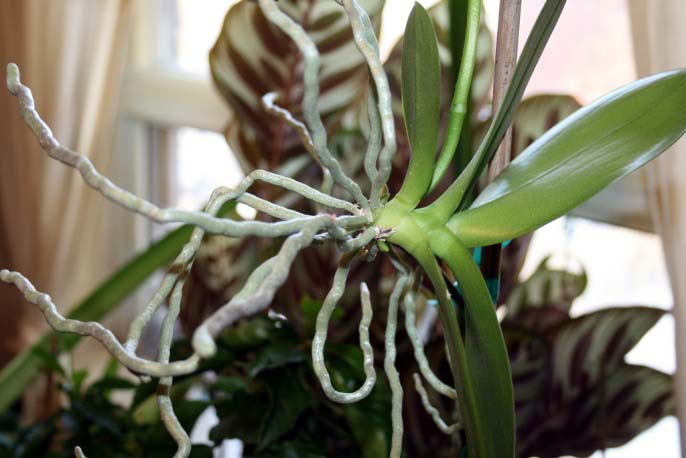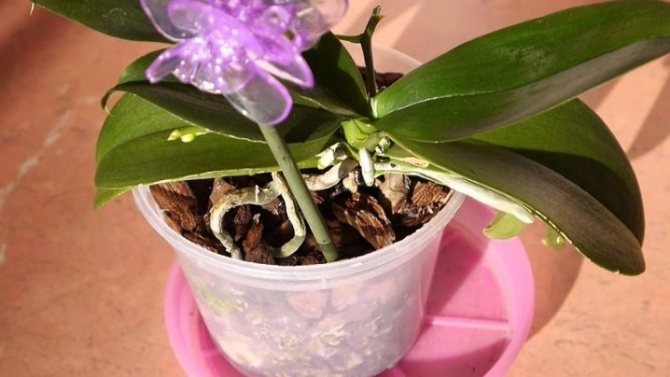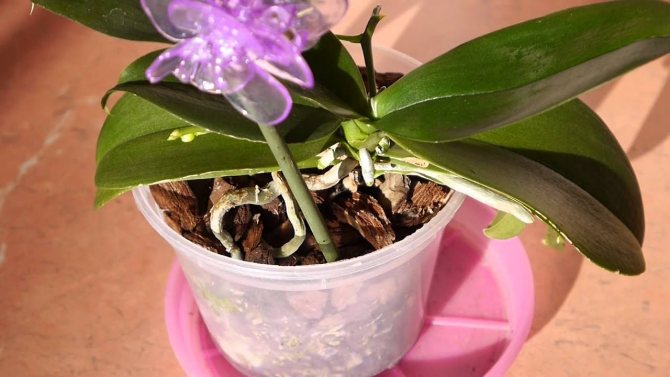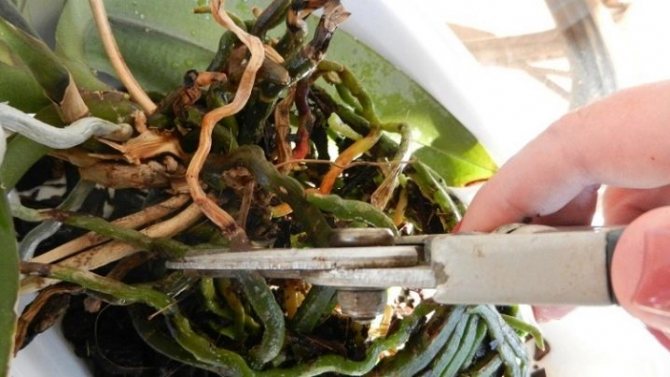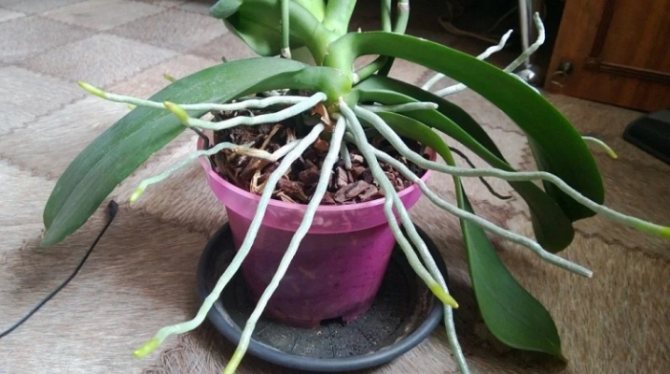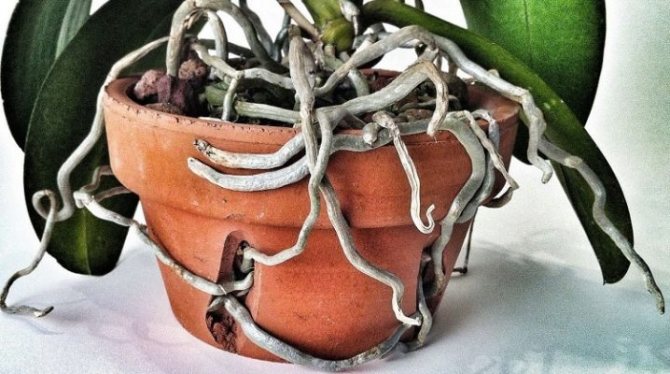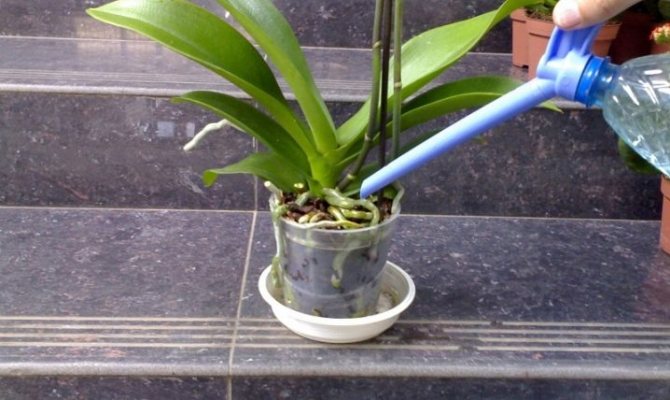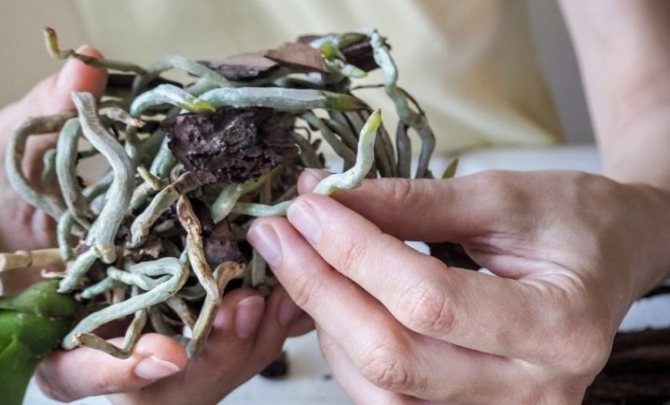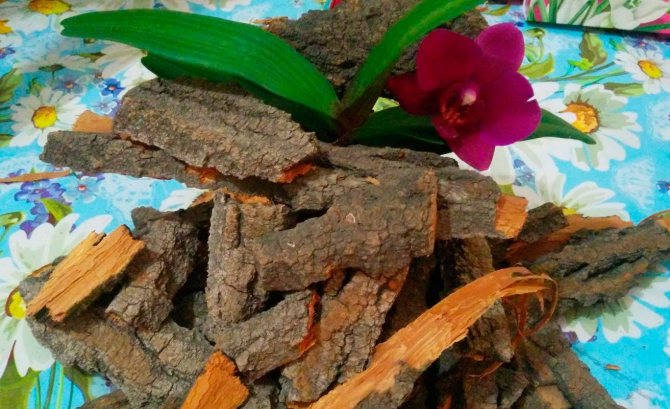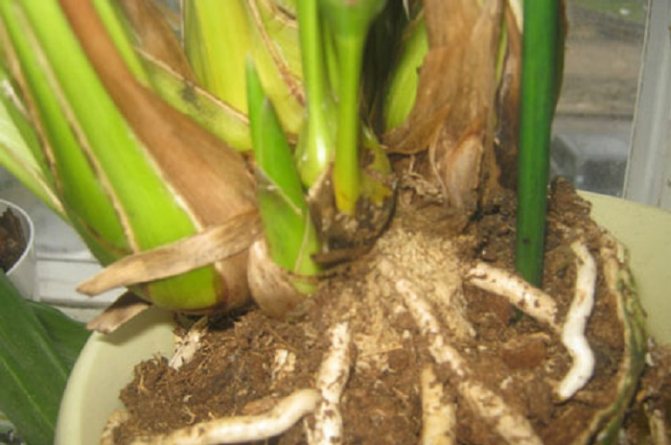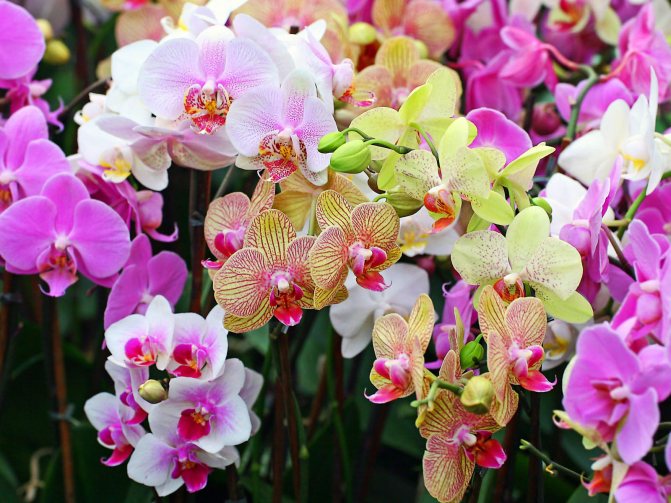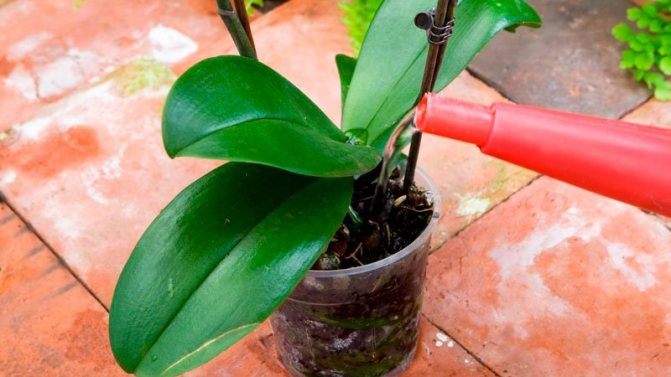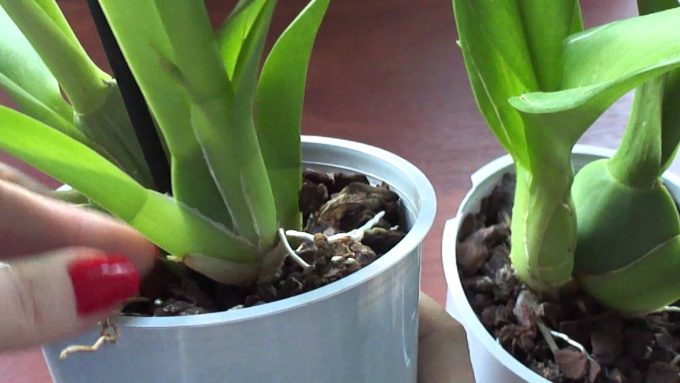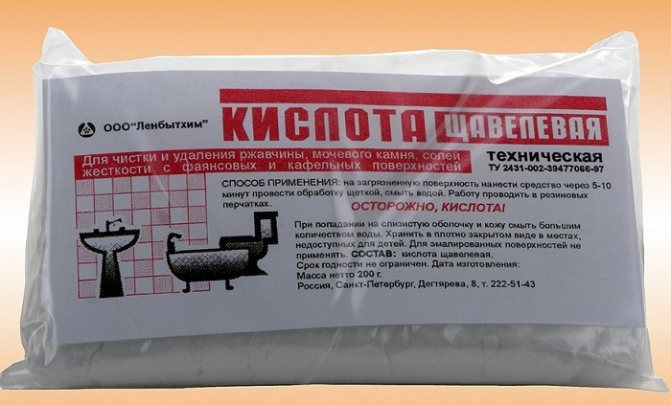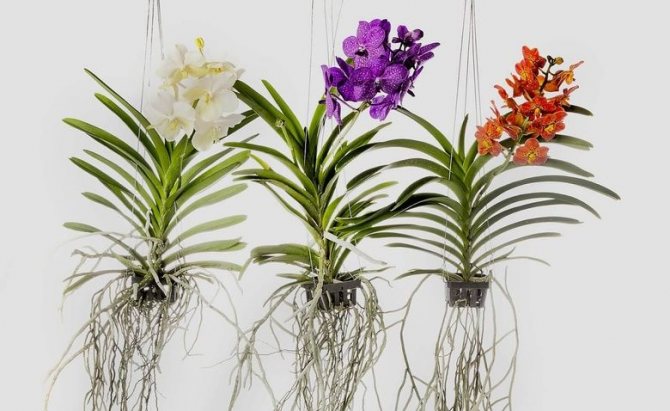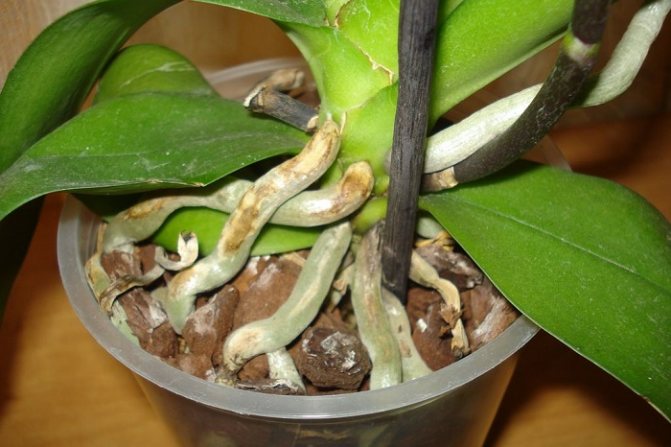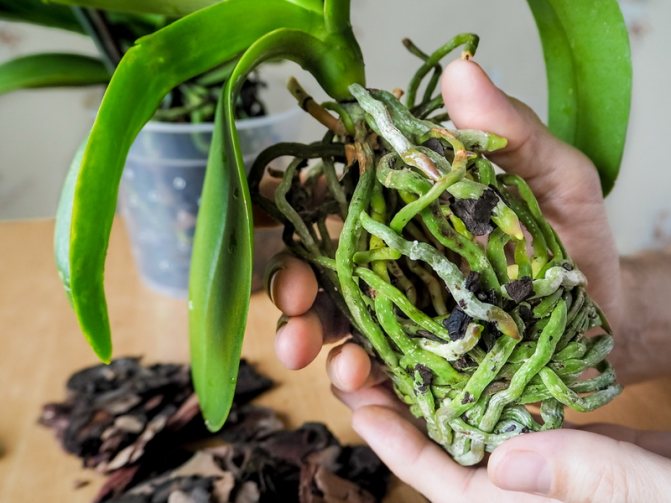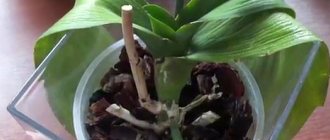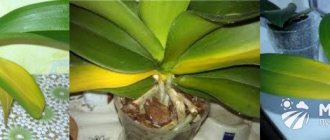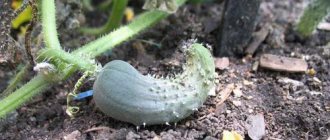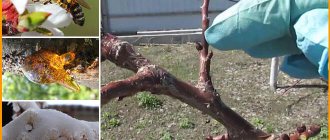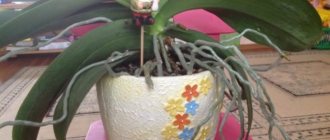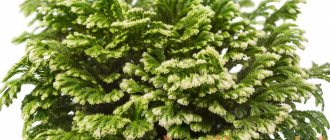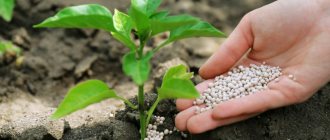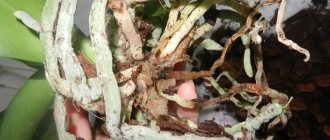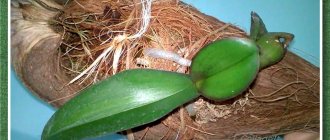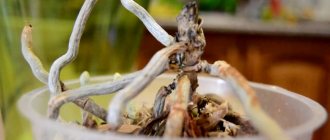Plants »Flowers
1
1008
Article rating
The aerial roots of the orchid are part of the plant's nutritional system. Their quality depends not only on the development of the epiphyte, but also on its health, as well as the strength and frequency of flowering. Root damage is manifested by drying out. A similar state of aerial shoots threatens the death of the flower. That is why you need to deal with manifestations immediately.
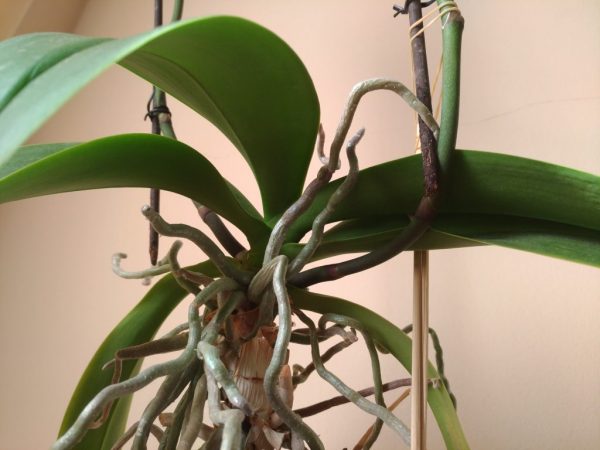
Orchid aerial roots
Features of the structure of underground air vegetative organs
Understanding the structure of plants is the job of breeders and botanists. To succeed in growing "tropical beauties" requires knowledge of the vegetative part and the root system of plants.
Orchid roots are an osmotic membrane that moves fluid from highly concentrated areas to unsaturated areas. The membrane surrounding the root cell is permeable only to water and oxygen molecules. Protein molecules in a dissolved state inside the cell are impenetrable. Therefore, proteins necessary for biological processes remain inside the cell.
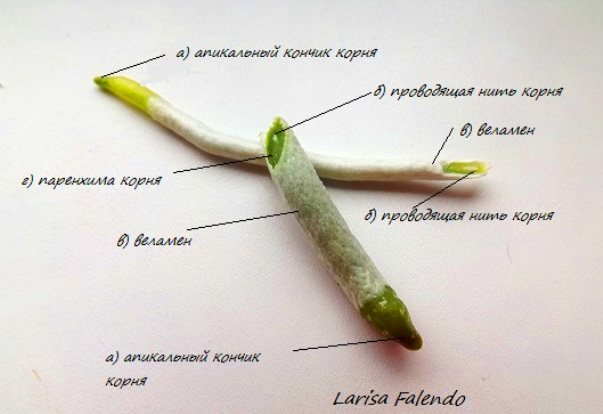

The transfer of fluid through the membrane occurs in the upper part of the bulb - the rhizoderm. The primary covering tissue of the root system is responsible for the absorption of water and nutrients and is covered with microscopic root hairs. From the rhizoderm, the fluid enters the conductive tissue of the core, transports it to the vegetative part. The primary covering tissue of orchids is very delicate. Therefore, if it is damaged, the flower will immediately begin to hurt.
On a note! The root system of many orchids can release many tentacle roots only because of the genes laid down by nature. In nature, epiphytes need to cling to a plant or stones in order to continue the genus.
Alive
Rhizome rhizomes with and without bulbs grow in orchids in a horizontal direction in the form of an underground or aerial shoot with limited growth. The living roots of Phalaenopsis, Vandas and Ascocendum have a growing light green tip. The hygroscopic tissue of healthy roots is firm and elastic. When pressed on the root mass, no putrid smell emanates from it. Living bulbs inside the substrate may take on a light brown hue. However, if the hygroscopic tissue is elastic, the roots are alive.
Dead
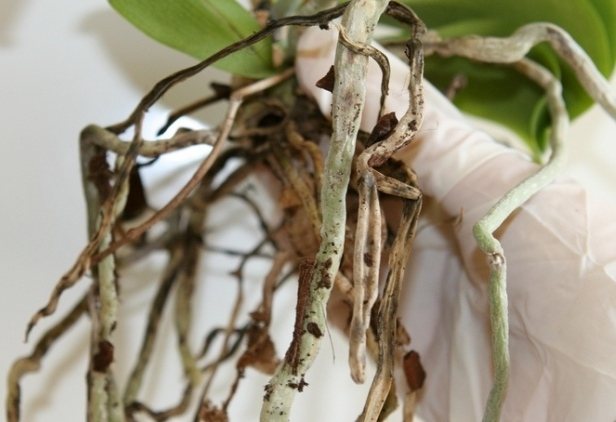

Often a healthy-looking root system has a dead area in some places. Such a vegetative organ is no longer useful for a plant to pump liquid into osmosis. In addition, it can become a source of infection for stems. Therefore, when examining the lower part of the plant, pay attention to the condition of the roots. If a healthy externally hygroscopic tissue is easily squeezed when pressed, the root dies.
Growing up from the pot
If an orchid has several roots growing upward, but at the same time the substrate underground organs are healthy and develop well, there is no reason to worry about the plant. It is worth taking measures if the orchid has a lot of air bulbs, and the underground part stops developing.
With high humidity and plant illumination for more than 16 hours a day, air bulbs grow very quickly upward, growing to 25-35 cm. A thick layer of dead hollow cells grows at such roots.
On a note!
The layer of dead cells of velamen is a natural barrier between the root and the surrounding air. Therefore, under unfavorable conditions, it protects the air underground vegetative organs from overheating and drying out.
The roots are yellow and soft - a sign of decay. How to treat?
Yellow plaque can be caused by a pathogen of bacterial or fungal rot, such the plant needs urgent treatment.
Fungal diseases of the root system often accompanied by the formation of yellow mold on the roots, the appearance of yellow balls (mycelium plexus) and plaque. If these signs are found, as well as in the case of bacterial root infections:
- orchid extracted from the soil, the roots are washed with warm water;
- disinfected instrument remove all unhealthy roots;
- the cuts are rubbed crushed activated carbon;
- with fungal infection of the root system soaked in solution with 0.2% Fundazole solution for 15 minutes;
- if the roots are infected with bacterial rot, they are treated with bactericidal preparations based on copper - copper hydroxide (CuOH), copper peroxide (CuO2) or Bordeaux liquid.
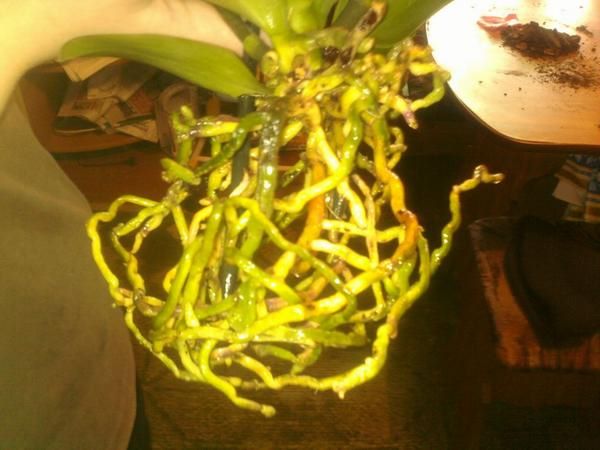

Crystalline copper acts as a mechanical barrier to prevent the spread of disease along the root surface.
To consolidate the positive effect, the procedure is carried out three times with an interval of 10-14 days... Then the plant is transplanted into a new substrate and a new pot and create optimal conditions for keeping.
The consequences of overgrowing aerial roots
The division of the root system of indoor epiphytes and petrophytes into air and underground is incorrect. According to their structure and functions, their underground vegetative organs are all airy. In nature, plants use stones or a nutrient medium to anchor to surfaces.
However, if the roots of the orchid crawled out of the pot very strongly, their incorrect, uneven growth can lead to the development of pathologies. Under unfavorable growing conditions, overgrown lower vegetative organs will lead to the death of the flower.
Drying
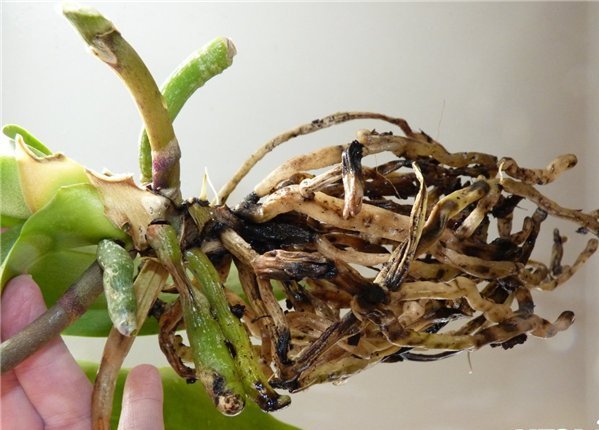

Due to the strong overgrowth of the air organs and with the wrong irrigation regime, the root system dries up. With insufficient humidity, the stage of artificial drought develops, after which peduncles actively grow, buds and inflorescences develop. Therefore, if the roots of the orchid crawled out of the pot, then the apical part remains beautiful and healthy.
The increased moisture content of the substrate leads to a decrease in the size of cells and tissues of the root system. This leads either to decay, or to the drying out of the organ. To remedy the situation, it is worth changing the watering regime, gradually increasing the interval between the supply of fluid to the root system.
Mold growth
The process of destruction of protein substances under the action of microbial enzymes of air bulbs of wands, ascocendas, and phalaenopsis is a frequent problem faced by flower growers. What to do with the aerial roots of orchids when decaying?
Usually ammonification of the root system occurs due to the increased amount of moisture in the pot. Liquid stagnation can be avoided by controlling the watering of the soil mixture. In addition, you can make more drainage holes in the container.
On a note!
After watering the flower, drain the water from the pan after 4-6 minutes. If this is not done, pathogens, mushroom mosquitoes, mealybugs may appear in the substrate.
Redness of the tips
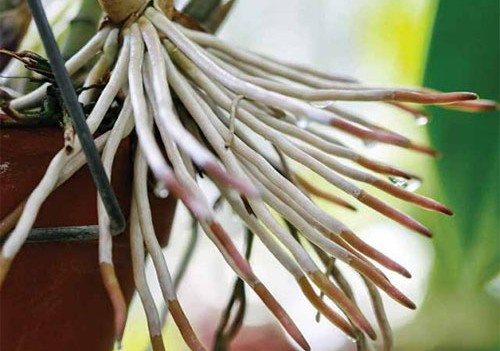

Orchid lovers who have little experience in growing the plant often observe reddening at the tips of the underground air organs. This sign is not a symptom of the disease, but indicates that young roots are actively growing.
"Rust" or blackening
Often inexperienced florists are intimidated by the black-rusty shade of the bulb.If the roots of the orchid have crawled out of the pot and have acquired a black-rusty hue, the culture does not have enough moisture, direct sunlight falls on it. To correct the situation, remove the flower from the place of exposure to ultraviolet radiation, increase watering. If rust or dark brown spots have covered most of the plant, replace the soil mixture with a looser and more nutritious substrate.
The appearance of patches of pink or red hues
It may be interesting Flowers in the house - for joy, or for losses? Signs and foreign Abutilon: cultivation, care and reproduction at home Saintpaulia: species and varieties with a description, cultivation and care at home
If an orchid has a lot of aerial roots, on which a peculiar tan appears at elevated temperatures in summer, then this manifestation is not a pathology. There is no need to treat it.
However, a reddish tinge on hygroscopic tissue may indicate the development of fusarium wilting. The disease causes damage by spores of the species of imperfect fungi F. oxysporum Schlectend. Mitospores form reddish patches on the roots. Favorable conditions for the development of pathology are:
- high humidity;
- bad light;
- low room temperature.
During reproduction, condids overlap the main vessels of the roots and stem. The flower becomes dehydrated and withers. To neutralize the disease, set the plant aside from the rest of indoor flowers, cut off and throw away diseased areas, treat the affected areas until complete recovery with fungicides.
Stiffening
When buying an orchid, often its root system looks green, but shriveled and woody. More often than not, growers who grow a plant for sale on an industrial scale overfeed the pets. At the same time, the flower received nutrients in such an amount that it "did not know" what to do with the overexpenditure. Therefore, the underground vegetative organs began active growth directly from the point of growth of the peduncle and became stiff. In this case, the orchid needs to be fertilized with special dressings only on the leaf for several months.
Transfer
New orchid growers are often horrified at the prospect of replanting orchids. A common mistake is to transplant an orchid into an old, already spent substrate, so the plants lose their roots and the ability to survive. The substrate decomposes during the growth of the orchid and must be replaced during transplantation. Transplanting on time and in the correct substrate will help ensure the survival of your orchids and your confidence as an orchid grower. The best time to transplant an orchid is when new roots have just appeared, because the plant will acclimate faster.
To be careful, you can replant when the new roots are about 6-12 mm in length. These new roots can easily break during transplanting and, if damaged, will not grow back, so if they are larger than 12 mm, wait until they are 10 cm or more before replanting. Long roots, even when damaged, continue to branch and grow.
Root growth of some orchid species is almost impossible to initiate except at very specific phases in the growth cycle.
Some two-leaved Cattleya species release very few roots per year and, if damaged or destroyed, there will be no new regrowth until next year at the same time. Two-leaved Cattleya should only be replanted when new roots emerge from new growth.
Troubleshooting
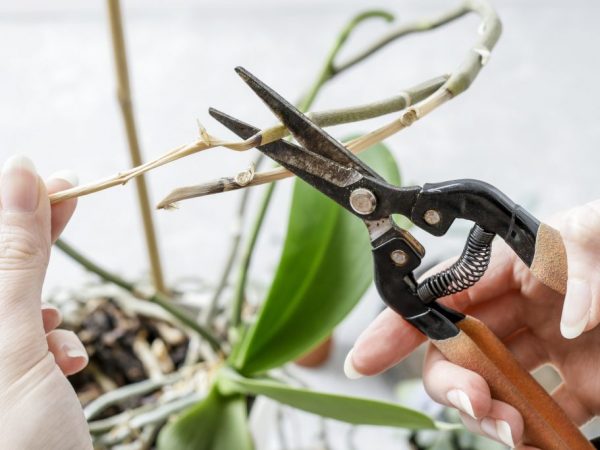

Several underground vegetative organs that have crawled out of the pot are not a problem. In this case, you do not need to cut off the aerial roots of the orchid. However, a large number of them indicate wrong agricultural practices that need to be revised. You do not need to immediately take up the tool and cut the roots of the orchid. First, adjust lighting and watering.If the flower is cramped, transfer it to a large container.
You need to transplant the orchid very carefully, since its bulbs are fragile. Before removing the stem from the pot, rinse the roots from the old substrate, inspect for rot and lumber. If there are deviations, trim the roots, plant in a new soil mixture.
On a note!
If the plant is cramped, it's easy to understand. The stem has pale, limp foliage. Transplant an orchid culture only after flowering, looking closely at the roots. If the tips of the vegetative underground organs turned green, the plant started to grow.
Instrument preparation
To trim Vanda, Phalaenopsis, Dendrobium or Cattleya, use a pruner or knife. Decontaminate the instrument before use to avoid contamination. To disinfect, wipe the cutting part with chlorhexidine, vodka or cologne. Do not use small scissors for manicure or pedicure. The tool can injure delicate leaves.
Trimming and processing after the procedure
It is only necessary to prune a plant with rotten or partially injured roots sticking out. If the underground vegetative organs crawl out of the container a little, you do not need to do anything with them.
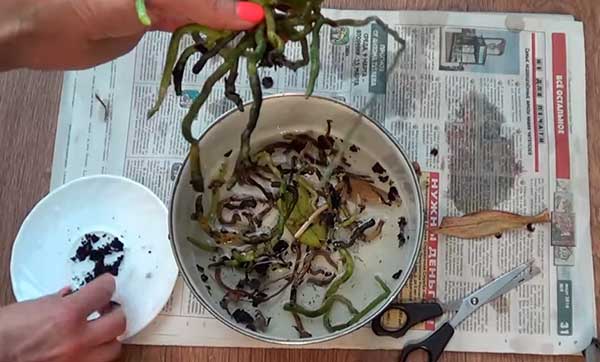

To save the plant, perform the following activities:
- remove the stem from the planting pot;
- rinse the roots under running water;
- dry the plant for five to six hours at an air temperature of + 20- + 25 degrees;
- carefully inspect the air roots: when pressed, a liquid with an unpleasant odor appears from the damaged areas;
- cut off necrotic and injured areas, dry in a warm place for 2-3 hours;
- treat orchid roots after pruning with wood ash or activated carbon powder.
On a note!
Sprinkle the slices on the plants with regular cinnamon. The spice is a natural antiseptic containing the disinfecting oil eugenol.
Further agricultural methods for rescuing roots in a room orchid depend on the type of culture, on the amount of damage to the vegetative underground organs. If the roots are slightly injured, illuminate the plants with fluorescent lamps for at least 20 hours a day, transplant them into a light porous material with the addition of sphagnum moss.
Prevention for the future
In order not to worry about your pet's health, it is important to properly organize care.
- The lighting is diffused, the duration of daylight hours is 14 hours.
- Summer temperature + 22-25 ° C, winter + 16-18 ° C.
- The difference in temperature differences should not exceed 5 ° C.
- Humidity 60%.
- Watering once every 7 days. In between, the soil must dry completely.
- Spray daily, just not during the flowering period.
- The water temperature should be 40 ° C.
- Transplant regularly, every 2-3 years.
- Choose a pot that matches the size of the flower.
- Be sure to ventilate the room.
The reasons for the yellowing of an orchid are varied.... But it happens that a combination of negative factors is to blame. At the same time, one should not forget that proper care and comfortable conditions of detention are important. Take care of your exotic beauty, which will preserve health and longevity.
The period when the event cannot be held
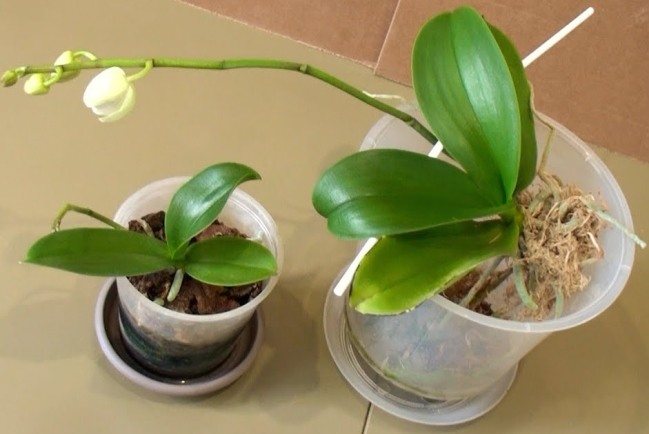

There is a contraindication for cutting off the vegetative air organs that grow from the pot. So, for example, you cannot prune bulbs when the plant is in the flowering stage. Despite the fact that this agricultural technique is aimed at improving the condition of the orchid, it is a great stress for the plant.
After flowering, the orchid culture needs a transplant, so removing the roots that are climbing out of the container is a necessary procedure. If you trim the aerial vegetative organs during flowering, the plant will drop its buds, stop forming ovaries. In addition to the flowering period, you can trim the bulbs at any time.
What color does a healthy root system have?
It is the roots that are an important organ of plants, in particular orchids.They nourish the plant with liquid, minerals, and participate in the process of photosynthesis. Orchids are known to have aerial and internal roots.
- Shades of healthy roots - light green, light gray, when moisturized, the color becomes more saturated, dark green.
- Abnormal root color - brown, light yellow with a white bloom.
I would like to add that determining the state of the root system solely by color is not correct. After all, the color can change depending on the composition of the substrate, insufficient lighting, the use of mineral fertilizers, and natural features.
Healthy roots: firm, smooth, firm. And if the root is easily pressed with a finger, inside is hollow, soft or flaccid - soon it’s all lifeless.
Plant follow-up
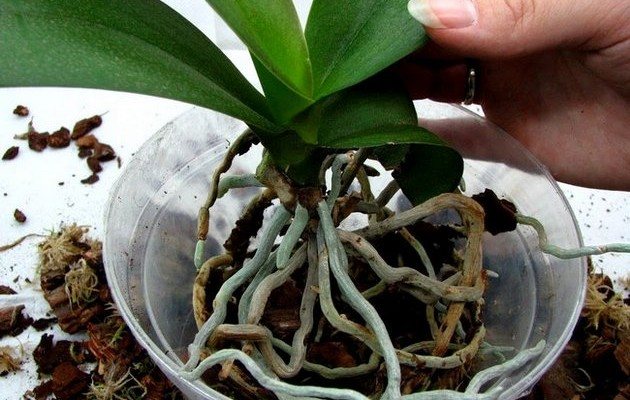

Within three to five days after pruning even a few aerial roots, you cannot water the orchid. The stem should recover completely after the procedure. Watering will cause the hygroscopic tissue to rot.
After pruning, place the plant in a "permanent residence" in a new flowerpot sterilized with alcohol or boiling water. Remember to place the largest pieces of bark on the bottom of the pot. Holes on the bottom of the container for draining the liquid can be made with a hot awl or knitting needle.
When air roots-tentacles grow out of a flowerpot, you do not need to be frightened, since this process is non-deviation. However, improper care of the bulbs will cause their active growth, impairment of the functions of photosynthesis.
General information
Aerial roots have a variety of functions. For many plants, this variant of the root system is a supporting formation and supports the ground part.
In epiphytes, a root system of this type develops in order to collect moisture from the atmosphere, which is due to the special conditions of the natural habitat of plants and the lack of water in the bark of the trees on which they live. The aerial root system is equipped with a special type of spongy covering, which is called Velamen. This cover is made up of cells that greedily suck in moisture and work according to the principle of capillaries. The aerial root system of epiphytes never penetrates into the soil layers.
Interestingly, in some exotic plants, the aerial root system is represented by green assimilating roots that fulfill the functional purpose of leaves and sometimes take on a flattened shape.
